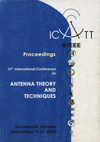The shipborne radar antenna pattern at over-horizon object observation
DOI:
https://doi.org/10.1109/ICATT.2003.1238805Keywords:
antenna radiation patterns, electromagnetic wave refraction, marine radar, microwave antennas, microwave propagation, radar antennas, tropospheric electromagnetic wave propagationAbstract
The paper considers the possibilities for shipborne radar (λ = 4.5 cm) to detect over-the-horizon objects in higher refraction conditions. It is shown that, due to antenna pattern adaptation to high refraction coefficient gradients in the troposphere lower layers, the radar receiver output signal-to-noise ratio can increase by 20-23 dB.References
Homenko, S.I.; Zatserklyany, A.E.; Kulik, D.Y. Shipbome radar antenna adaptation to the higher refraction conditions. Proc. of Crimea Conf. on Micro wave technique and satellite reception, 20-23 Sept. 1993, Sebastopol, Ukraine. 1993, Vol. 6, pp. 782-785.
Kalinin, A.I. Radio waves propagation on Earth’s and space routes. M.: Svyaz, 1979, 269 p.
Kabanov, V.A.; Turgenev, I.S. Refractometer measurements with the help of helicopter. Radio Engineering, 1980, No. 52, p. 94-97.
Dorfman, N.A.; Kabanov, V.A.; Kivva, F.V. Refractometer measurements of the atmosphere refraction index in above water layer. Radio Engineering, 1980, No. 52, p. 91-93.
Troitskij, V.N. About microwave fades on the relay communication links. Electric Communication, 1957, No. 10, p. 31-39.

